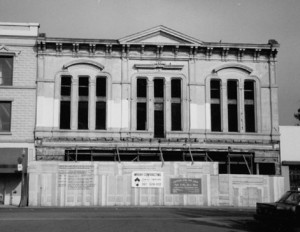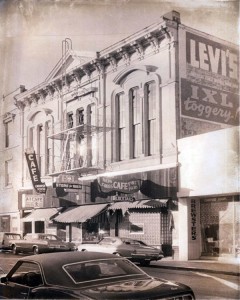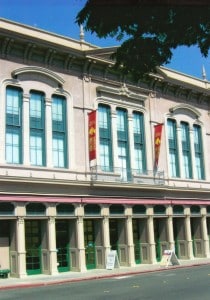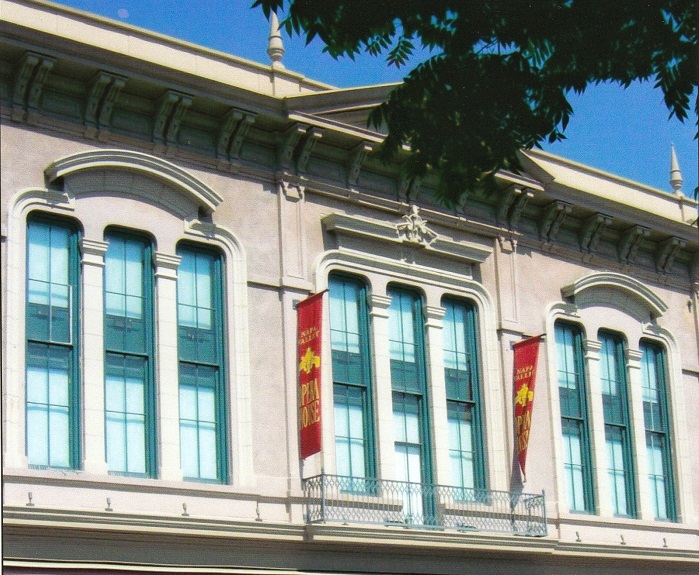Napa
Ups and Downs of the Napa Valley Opera House
By Ted Tyson
Beginning in June 1879, George Crowey and Ellen Hogan commenced designing a new opera house with architect Ira Gilchrist and contractor John Cox. In association with Joseph and Samuel Cather Newsom, they worked out their dream in what was then Napa’s Hotel District. By October 1879, plans were becoming a reality. The roof was under construction on the 29th of that month, and there the workers had a ring side seat to the first travail to beset the Opera House. Two of Crowey’s sons, John and William, got into a fight with August Ruesch, the cook at the William Tell Hotel. George tried to break it up. Crowey and his sons were tried for murder when Ruesch died from injuries received in the pummeling. G.W. and William were acquitted while John was found guilty of murder and sentenced to San Quentin.

The Opera House was competed about a month late and was celebrated with a grand ball sponsored by the Unity Club on January 9, 1880. Unfortunately, Ira Gilchrist, its architect, fell from a ladder December 18, 1879, and died one week after the opening. On February 13, 1880, the first play, Gilbert and Sullivan’s H.M.S. Pinafore was performed by the Standard Theatre and the San Francisco Orchestra. The same troupe also did Trial by Jury the following night.
 April 1880 brought another of the downs. A flood damaged the foundation and threatened the future of the new opera house. Fortunately, it was quickly repaired. November 18, 1902, was also ominous. Professor Bradshaw presented His Exhibition on the Moving Pictures. He was using the latest Edison Perfected Projecting Kinetoscope. It was the growing fascination with motion pictures that spelled the demise of the Opera House. After 1910 the theatre was abandoned; $30,000 in construction costs for 30 years of life.
April 1880 brought another of the downs. A flood damaged the foundation and threatened the future of the new opera house. Fortunately, it was quickly repaired. November 18, 1902, was also ominous. Professor Bradshaw presented His Exhibition on the Moving Pictures. He was using the latest Edison Perfected Projecting Kinetoscope. It was the growing fascination with motion pictures that spelled the demise of the Opera House. After 1910 the theatre was abandoned; $30,000 in construction costs for 30 years of life.
World War I called the Opera House into service once again. It was used as an armory for the local guard. That renaissance was brief, however, and it was abandoned again after the war. All the seats, curtains, chandelier, and other original fixtures had long disappeared.
 After Crowey’s death Ed Hogan sold the property. The Catholic Church owned for a time but had little use for it. In the 1940s, the theatre was a storage loft for carpeting. Frank Corsetti owned the property and rented out the lower floors to a Chinese restaurant, western wear store, and a bar were his tenants until the 1970s when interest was revived by OPERA (Opera Preservation and Restoration Association). During this time the structure was added to the National Register of Historic Places.
After Crowey’s death Ed Hogan sold the property. The Catholic Church owned for a time but had little use for it. In the 1940s, the theatre was a storage loft for carpeting. Frank Corsetti owned the property and rented out the lower floors to a Chinese restaurant, western wear store, and a bar were his tenants until the 1970s when interest was revived by OPERA (Opera Preservation and Restoration Association). During this time the structure was added to the National Register of Historic Places.
 The non-profit group Napa Valley Opera House (NVOH) was established in the 1980s, spearheaded by artist Veronica di Rosa and local historic preservationists John Whitridge and Thomas Thornley. A decade later they restored the façade, and, with the financial assistance of Robert and Margrit Mondavi, raised over $2 million for restoration. The theatre opened in 2002, and on August 1, 2003, the main stage held a grand re-opening with a revival performance of H.M.S. Pinafore.
The non-profit group Napa Valley Opera House (NVOH) was established in the 1980s, spearheaded by artist Veronica di Rosa and local historic preservationists John Whitridge and Thomas Thornley. A decade later they restored the façade, and, with the financial assistance of Robert and Margrit Mondavi, raised over $2 million for restoration. The theatre opened in 2002, and on August 1, 2003, the main stage held a grand re-opening with a revival performance of H.M.S. Pinafore.
In the 2010s, the Opera House brought on City Winery as a way to save the building and the program. Their plan to use the lower floor as a restaurant and the theatre as restaurant and bar with a ten year lease seemed a sure bet. Yet after only a few years, City Winery departed, leaving their extensive interior modifications behind. Blue Note Jazz Club is scheduled to reopen the opera house in summer 2016.
Bibliography
Napa Valley Register: The Grand Old Lady By Rebecca Yerger July 30, 2003
Napa Valley Opera Centennial : News Release from the Napa Opera Preservation and Restoration Association January 7, 1980 Contact: John Whitridge
Crowey’s Opera House Diane Rowland A paper for Drama 150( Mr. Robert Sarlos) Ms. Rowland relied heavily on a 1948 Napa Journal Article by Virginia Hanrahan.


